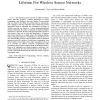Free Online Productivity Tools
i2Speak
i2Symbol
i2OCR
iTex2Img
iWeb2Print
iWeb2Shot
i2Type
iPdf2Split
iPdf2Merge
i2Bopomofo
i2Arabic
i2Style
i2Image
i2PDF
iLatex2Rtf
Sci2ools
CISS
2007
IEEE
2007
IEEE
Bounding A Statistical Measure Of Network Lifetime For Wireless Sensor Networks
—The inherent many-to-one flow of traffic in Wireless Sensor Networks produces a skewed distribution of energy consumption rates leading to the early demise of those sensors that are critical to the ability of surviving nodes to communicate their readings to the data collection center. Numerous previous approaches aimed at balancing the consumption of energy in wireless networks are based on a linear programming-based minmax formulation that seeks to maximize the minimum lifetime of sensors in a network. However, this approach fails to provide a clear picture of the cost at which this optimization is achieved and focuses attention on a single sensor, the minimum lifetime sensor. This paper makes two contributions; 1) it puts forward a new understanding of sensor network lifetime based on statistical measures, mean and variance, of node power consumption rates that provides a more inclusive view of the consumption rates, and 2) it provides an optimal quadratic programming (QP) formula...
| Added | 02 Jun 2010 |
| Updated | 02 Jun 2010 |
| Type | Conference |
| Year | 2007 |
| Where | CISS |
| Authors | Muhammad Usman Ilyas, Hayder Radha |
Comments (0)

